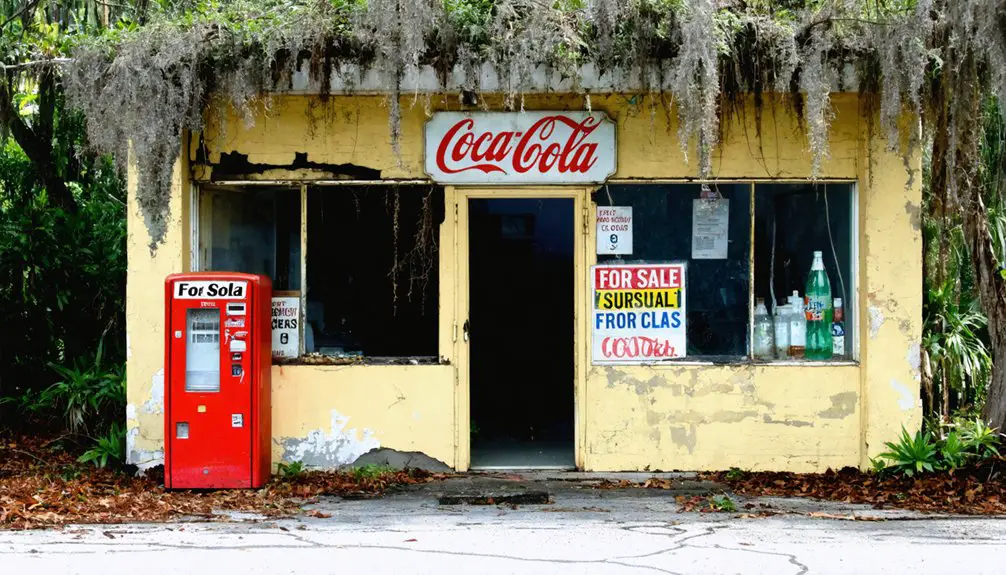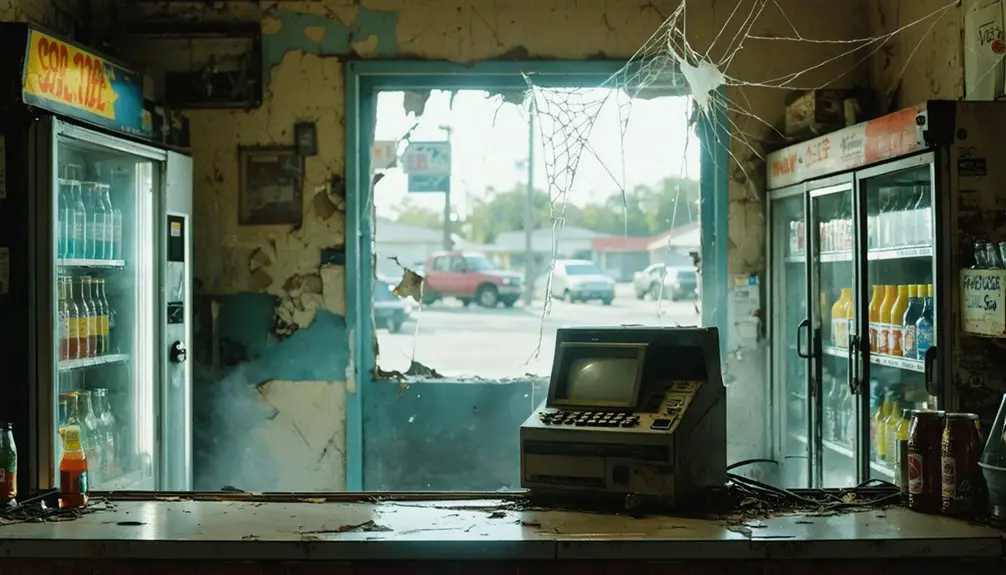You’ll find Sun City’s remains near Ruskin, Florida – a failed 1920s attempt to create “Hollywood of the East.” The development boasted a $300,000 Universal Studios facility, movie star-named streets, and modern amenities until Florida’s 1926 real estate crash destroyed its prospects. After multiple revival attempts, including J.T. Fleming’s 1930s vision of a filmmaker’s paradise, Sun City devolved into a site of social struggle and exploitation. Today’s weathered ruins tell a deeper story of boom, bust, and transformation.
Key Takeaways
- Sun City was developed in the 1920s as Florida’s movie colony with a $300,000 Universal Studios facility and movie-star-themed streets.
- The town experienced rapid decline after Florida’s real estate crash in 1926, leading to Universal Studios’ closure and mass exodus.
- W.W. Staplen purchased the entire failed movie colony for just $100 at auction in 1932.
- The site later housed controversial labor camps that exploited African American workers until a fire destroyed the facility in 1972.
- Today, only weathered buildings, a deteriorating railroad station, and overgrown flatlands remain as evidence of Sun City’s past.
The Birth of Florida’s Movie City Dreams
In the early 1920s, a small Florida town called Ross transformed into an ambitious movie colony venture when the Sun City Holding Company, led by Miami realtor J.H. Meyer and Cleveland railroad investor H.C. Van Swearingen, acquired 500 acres for development.
Their vision aimed to create Florida’s own Hollywood, complete with a $300,000 Spanish-Moor style Universal Studios facility. Initial success was promising as land sales reached $2 million.
The cultural impact of this development was immediate, as streets took on glamorous names like Mary Pickford Avenue and Charlie Chaplin Drive.
You’d find all the essentials of a thriving community: a school, hotel, theater, church, city hall, and power plant.
The studio’s unique visitor’s gallery let you watch real movies being made, while the entire project promised an exclusive lifestyle where you could live among the stars of the silver screen.
The grand opening was celebrated with a dedication ceremony by Tampa Mayor Perry Wall in 1925.
From Boom to Bust: The Rise and Fall
The grand dreams of Florida’s own Hollywood came crashing down as the state’s real estate bubble burst in early 1926.
Much like Tampa’s yellow fever epidemics of earlier decades, natural disasters and economic hardship devastated the region’s growth.
Sun City Holding Company dissolved amid the economic downturn, and a devastating hurricane struck, further crippling the area’s tourism and development prospects.
The town hit rock bottom when W.W. Staplen purchased the entire city for just $100 at auction in 1932, with no other bidders showing interest.
Life After the Movie Studios
After Universal Studios shuttered its doors in early 1926, Sun City’s once-promising future rapidly unraveled.
The film industry’s departure triggered an economic collapse that was further intensified by the devastating 1926 Florida hurricane.
You’d have seen residents and investors fleeing the area as property values plummeted and tourism dried up.
This decline marked a stark contrast to when Florida was the “Winter Film Capital” of the world in the early 1900s.
The area’s film legacy would later be revived when Disney-MGM Studios opened in the early 1990s, ushering in a new era of Florida filmmaking.
The Fleming Revival Attempt
In the late 1930s, you’d find J.T. Fleming acquiring 500 acres of Sun City for just $100, dreaming of transforming the ghost town into a thriving movie-making community where filmmakers and residents could live together.
Much like his distant relative who established Hibernia in 1783, J.T. Fleming had grand visions for developing a significant Florida destination.
You’ll see his ambitious vision crumble as he became entangled in endless legal battles against local government entities and even the U.S. President, stalling any meaningful progress for 15 years. Similar to modern commercial spaceflight regulations, bureaucratic hurdles proved challenging for ambitious development plans.
Fleming’s prolonged struggles took their toll, leading to his institutionalization in 1953 for 19 months, effectively ending his attempt to revive Sun City’s entertainment industry dreams.
Fleming’s Bold Vision
During the late 1930s, J.T. Fleming purchased 500 acres of Sun City land for a mere $100, igniting his ambitious vision to create Florida’s own Hollywood.
Fleming’s ambition centered on transforming this southern Hillsborough County property into a unique fusion of film industry and residential life. You can trace his Hollywood dreams through his strategic plans to establish a moviemaking hub that would rival California’s entertainment empire. Like the pioneering spirit of WT Collier’s arrival, Fleming saw untapped potential in undeveloped Florida land.
He believed the land would skyrocket in value to millions once his vision materialized. Despite facing mounting legal battles and financial hurdles, Fleming pushed forward with his revival attempt.
While his East Coast Hollywood never came to fruition, his legacy lives on through movie-themed street names and the original power plant on Route 41, standing as silent witnesses to his bold, innovative concept.
Legal Battles Derail Plans
Legal battles quickly engulfed J.T. Fleming after he acquired 500 acres of Sun City’s land for just $100.
You’d find him constantly at county commission meetings, launching legal disputes against everyone from the Florida road department to the President of the United States. His aggressive litigation created widespread ownership challenges that scared away potential investors and residents.
Like the controversial structures of Stiltsville in Biscayne, legal battles over property rights would shape Florida’s development for decades to come.
Fleming’s grand vision of transforming Sun City into a movie-making destination never materialized as court battles stalled critical infrastructure improvements.
The situation worsened when he was declared insane and committed to a psychiatric hospital in 1953. With no effective leadership and mounting unpaid taxes, much of the property reverted to the county.
His legal crusade had effectively sealed Sun City’s fate, leaving it largely abandoned through the mid-20th century.
Mental Health Downfall
Three crushing pressures converged to destroy J.T. Fleming’s dream of transforming Sun City into an eastern Hollywood: legal battles over property rights, mounting financial strain, and deteriorating mental health.
You can trace Fleming’s decline through the early 1950s as continuous court disputes drained his resources and blocked progress on the movie studio project. The weight of these challenges proved too heavy, and by 1953, Fleming’s mental state had declined so severely that he was declared legally insane.
He spent 19 months institutionalized, during which time his Sun City revival efforts ground to a halt. Though a Fulton County court eventually restored his rights, the societal impact of his failed vision left Sun City frozen in time – a ghost town that never realized its cinematic dreams.
Social Struggles and Transformation
You’ll find one of Sun City’s most troubling transformations in the fate of its segregated Black schoolhouse, which Hillsborough County operated until integration mandates forced its closure.
The building’s next chapter took an even darker turn when it became a controversial labor camp accused of enslaving workers through the 1960s.
The camp’s operation finally ended when fire destroyed the structure in 1972, marking another stark chapter in Sun City’s complex social history.
From School to Segregation
During the mid-20th century, Sun City’s educational landscape reflected Florida’s deeply entrenched system of racial segregation, with the Sun City School serving as a stark example of educational inequality.
Originally donated to the county, the school primarily served Black students in a community where most families worked as low-wage farm laborers. The segregation impacts were severe – you’d find the building in poor condition, fundamentally a shack off its foundation, while white schools received proper funding and maintenance.
These education disparities were legally enforced by Florida statutes dating back to 1889. Even after the 1954 Brown v. Board of Education ruling, you’d see fierce resistance to integration, with Governor Claude Kirk actively blocking desegregation efforts until federal pressure forced compliance in the 1970s.
Labor Camp Dark History
While Sun City’s educational segregation reflected systemic racism, the area’s labor camps represented an even darker chapter of racial oppression and human rights violations.
The old Black schoolhouse itself became a site of labor exploitation, where African American men endured brutal conditions under a system of peonage labor. You’d find armed guards enforcing violent control through daily whippings and threats, while workers suffered in torrid heat with inadequate water and dangerous tools.
This racial injustice thrived through collaboration between local sheriffs and business owners, who profited from forced labor by arresting Black men on false charges. The camp’s isolation made escape nearly impossible, though some found help from local fishermen.
The building’s fiery destruction in 1972 marked the end of Sun City’s most notorious labor camp, though its dark legacy endures.
Ghost Town Remnants Today

As nature slowly reclaims the landscape, Sun City’s remaining structures tell the story of its dramatic rise and fall.
You’ll find weathered gray shacks once inhabited by African Americans, alongside a deteriorating railroad station that still bears its original sign. A decaying powerhouse and warehouse stand as silent witnesses to the town’s industrial past.
The surrounding flatlands, now overgrown with palmetto and scrubby grass, show little evidence of the bustling movie town that once stood here.
Time and nature have erased almost all traces of the once-thriving movie town beneath the wild palmetto and grass.
The ghost town preservation efforts never materialized, leaving only scattered remnants of historical significance. The motion picture studio-turned-school met a fiery end in 1972, while other infrastructure was dismantled and sold off – from water pipes to power plant equipment.
Today, these ruins near the Little Manatee River serve as stark reminders of Florida’s 1920s boom-and-bust cycle.
Frequently Asked Questions
What Happened to the Original Film Equipment From the Sun City Studio?
You won’t find any film preservation of Sun City’s original equipment today – the entire studio’s legacy was lost when businessman W.W. Staplen dismantled and sold off everything after buying it at auction in 1932.
How Many Permanent Residents Lived in Sun City During Its Peak?
You’d think Sun City was just another ghost town, but its demographics peaked impressively at 30,952 residents in 2020, showing steady growth from 16,321 back in 2000’s census records.
Were There Any Notable Celebrities or Films Associated With Sun City?
You won’t find any major celebrity sightings in Sun City, though Universal Studios invested there by 1925. Only two short film productions were completed before the town’s dreams of rivaling Hollywood collapsed.
What Was the Total Cost of Building the Original Sun City?
You can’t pinpoint the exact construction expenses, but considering the $2 million in land sales, $35,000-75,000 homes, and extensive movie studio facilities, total costs likely exceeded $5 million in 1920s dollars.
Did Any Other Movie Companies Attempt to Use Sun City’s Facilities?
You’ll find that no other movie companies markedly utilized Sun City’s production facilities after Universal’s brief involvement. The film industry abandoned the site, leading to its dismantling by 1932.
References
- https://www.ghosttowns.com/states/fl/suncity.html
- https://hillsborough.wateratlas.usf.edu/upload/documents/HILLSBOROUGH_COUNTY_Historic_Resources_Excerpts_Sun City.pdf
- https://fsuspecialcollections.wordpress.com/2020/10/21/sun-city/
- https://www.observernews.net/2017/03/08/remember-when-14/
- https://www.youtube.com/watch?v=pjRdqRH_rHw
- https://en.wikipedia.org/wiki/Film_industry_in_Florida
- https://filminflorida.com/about-us
- https://en.wikipedia.org/wiki/History_of_Tampa
- https://en.wikipedia.org/wiki/Sun_City
- https://thefacesofsuncitycenter.com/sun-city-center-history/



